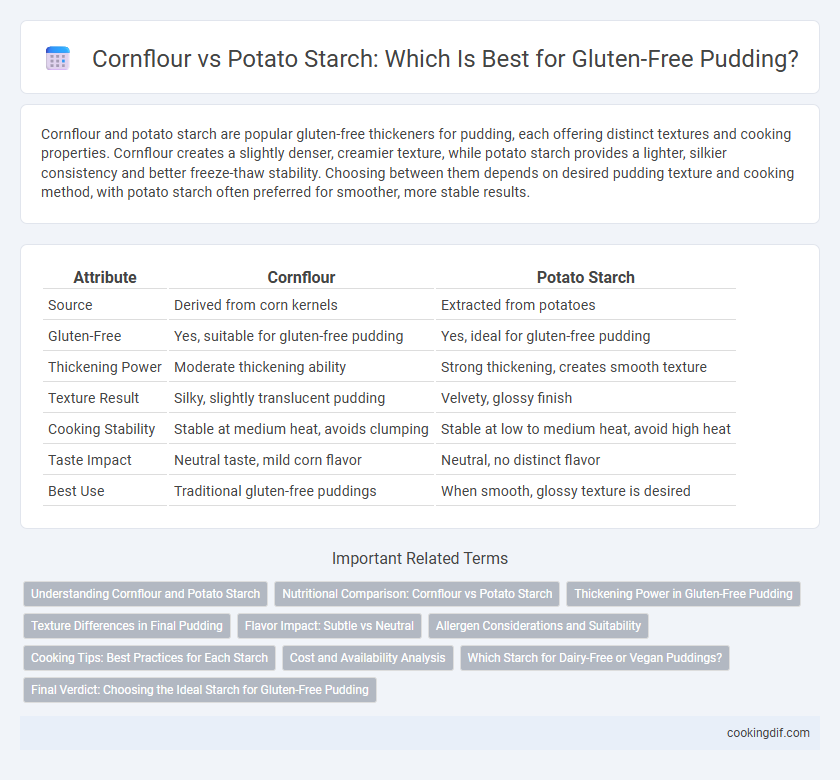Cornflour and potato starch are popular gluten-free thickeners for pudding, each offering distinct textures and cooking properties. Cornflour creates a slightly denser, creamier texture, while potato starch provides a lighter, silkier consistency and better freeze-thaw stability. Choosing between them depends on desired pudding texture and cooking method, with potato starch often preferred for smoother, more stable results.
Table of Comparison
| Attribute | Cornflour | Potato Starch |
|---|---|---|
| Source | Derived from corn kernels | Extracted from potatoes |
| Gluten-Free | Yes, suitable for gluten-free pudding | Yes, ideal for gluten-free pudding |
| Thickening Power | Moderate thickening ability | Strong thickening, creates smooth texture |
| Texture Result | Silky, slightly translucent pudding | Velvety, glossy finish |
| Cooking Stability | Stable at medium heat, avoids clumping | Stable at low to medium heat, avoid high heat |
| Taste Impact | Neutral taste, mild corn flavor | Neutral, no distinct flavor |
| Best Use | Traditional gluten-free puddings | When smooth, glossy texture is desired |
Understanding Cornflour and Potato Starch
Cornflour, derived from finely ground corn kernels, provides a translucent, smooth texture ideal for gluten-free pudding, while potato starch, extracted from potatoes, offers a glossy finish and stronger thickening power at lower temperatures. Both cornflour and potato starch are naturally gluten-free, making them popular alternatives for pudding recipes requiring a delicate, creamy consistency without gluten. Their unique thickening properties affect the pudding's texture and appearance, with cornflour yielding a slightly softer result and potato starch delivering a firmer set.
Nutritional Comparison: Cornflour vs Potato Starch
Cornflour contains more carbohydrates and slightly higher calories compared to potato starch, which is primarily pure starch offering minimal protein and fiber. Potato starch has a lower glycemic index, making it a better option for blood sugar control in gluten-free pudding recipes. Both are gluten-free, but cornflour provides marginally more vitamins and minerals, contributing to a modest nutritional advantage in pudding formulations.
Thickening Power in Gluten-Free Pudding
Cornflour and potato starch both serve as effective thickeners in gluten-free pudding, with potato starch offering a higher thickening power due to its larger granule size and greater water absorption capacity. Potato starch produces a silkier, more elastic texture that holds up better during cooking and cooling compared to cornflour, which can sometimes result in a slightly grainy or less stable consistency. For optimal thickening in gluten-free pudding recipes, potato starch is preferred when a smooth, resilient texture is desired.
Texture Differences in Final Pudding
Cornflour creates a smooth, silky texture in gluten-free pudding with a slightly denser consistency that holds shape well when chilled. Potato starch yields a lighter, more delicate pudding with a softer, creamier mouthfeel and a tendency to be slightly more translucent. The choice between cornflour and potato starch fundamentally influences the pudding's firmness and clarity, affecting its visual appeal and overall eating experience.
Flavor Impact: Subtle vs Neutral
Cornflour imparts a subtle, slightly sweet flavor that can enhance the natural taste of gluten-free pudding, providing a mild, creamy texture. Potato starch, however, offers a completely neutral flavor profile that allows other ingredients to shine without altering the pudding's taste. Choosing between cornflour and potato starch depends on whether a hint of sweetness or a clean, flavorless base is preferred for the dessert.
Allergen Considerations and Suitability
Cornflour and potato starch are both popular thickening agents for gluten-free pudding, but allergen considerations play a crucial role in choosing between them. Cornflour may trigger allergic reactions in individuals sensitive to corn proteins, whereas potato starch is generally hypoallergenic and better tolerated by those with common food allergies. For gluten-free pudding recipes targeting allergen-friendly options, potato starch offers greater suitability and minimal risk of cross-reactivity.
Cooking Tips: Best Practices for Each Starch
Cornflour thickens pudding quickly at medium heat, requiring constant stirring to prevent lumps and burning. Potato starch creates a smooth texture when dissolved in cold liquid before adding to the hot mixture and should be cooked at low heat to avoid thinning or a gluey consistency. For optimal gluten-free pudding, gradually incorporate cornflour or potato starch and remove from heat immediately once thickened.
Cost and Availability Analysis
Cornflour is generally more cost-effective and widely available in supermarkets, making it a budget-friendly choice for gluten-free pudding recipes. Potato starch tends to be slightly more expensive and may be less accessible in conventional stores, often found primarily in health food or specialty shops. Both thickeners provide similar texture outcomes, but cornflour's affordability and ubiquity give it an advantage in cost and availability for gluten-free pudding preparation.
Which Starch for Dairy-Free or Vegan Puddings?
Potato starch is ideal for dairy-free or vegan puddings due to its neutral flavor and glossy finish, creating a smooth texture without altering the taste. Cornflour can thicken puddings effectively, but it often imparts a slightly grainy texture and less transparency compared to potato starch. For gluten-free pudding recipes requiring a delicate, creamy consistency, potato starch ensures a superior mouthfeel and stability during cooking and cooling.
Final Verdict: Choosing the Ideal Starch for Gluten-Free Pudding
Cornflour offers a smooth, creamy texture ideal for traditional gluten-free pudding, while potato starch provides a slightly lighter, more delicate consistency with excellent thickening power. Cornflour is best suited for richer, dense puddings, whereas potato starch works well for recipes requiring a subtle, tender finish. For optimal results in gluten-free pudding, selecting the starch depends on desired texture and mouthfeel, with cornflour favored for creaminess and potato starch for a lighter, silkier pudding.
Cornflour vs Potato Starch for gluten-free pudding Infographic

 cookingdif.com
cookingdif.com